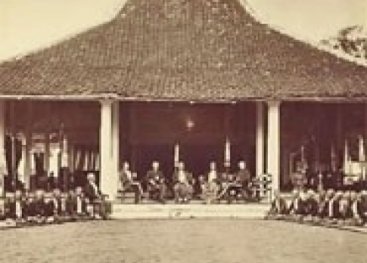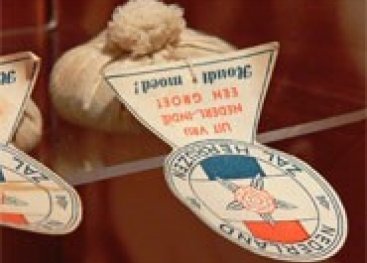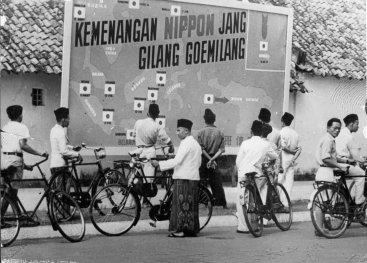
Life in the camps
Roll-calls
“We often had roll-calls, standing in lines of four alongside the barracks, sometimes several times a day. We often stood for hours in the baking sun. I always had a small piece of crochet work with me. It had to be small so I could hide it quickly if the Japs came by. If you were caught, they hit you hard. I was working on this crochet piece when we were liberated. I never finished it.”
Ria Bussink, 12 years old at the time.


Rules were tightened
The camps for the civilian detainees were initially not entirely closed off from the outside world. From mid-1943 the rules were tightened. Bamboo fencing with barbed wire was erected around the camps. All the inmates had to stand together for a roll-call twice a day. The inmates were forced to work. At night, everyone had to stay indoors, and no lights were permitted. Nobody was allowed any valuable possessions. There were regular checks, and infringements of the rules were punished severely. The camps were overflowing, and food became increasingly scarce. Around one in eight detainees died of exhaustion and malnutrition.
Men and women separated
The soldiers who had been made prisoners of war were put to work in camps, sometimes in the East Indies, but also in Burma, Taiwan and Japan. In the course of the occupation, all Dutch nationals and Dutch East Indians with ‘insufficient Indonesian blood’ were also imprisoned in camps: men and women separated. Boys stayed in the women’s camps until they were 10 or 12 years old, and were then taken away from their mothers.

Personal Stories - On transport
Dutch national Ineke Kuik, her mother and little brother lived with her uncle Guus and aunt Elly Rümke in Djombang when the family was detained.
“We were put in an overflowing train and sent first to Surabaya, then to the camp in Ambarawa, and were finally forced to walk to Banjubiru. My mother carried a rucksack and sleeping mat. My uncle and aunt had given me and my brother a set of silver cutlery each. Imagine: there was barely any food in the camp, but what we did have we would eat with our silver cutlery! I also had a porcelain doll. Uncle Guus had skilfully dissected the doll like a surgeon before we left, and had stuffed the body, arms and legs with my mother's jewellery. It included a valuable filigree brooch, bracelet and pendant made from Aceh gold. I played with the doll during my time in the camp. It could easily have fallen to pieces; luckily I didn’t know what was inside it.”
Camp elder
Dutch East Indian woman Jos Heijmans was camp elder in the women’s camp, Poelau Brayan. It was a difficult task, because it placed her between the Japanese and the camp inmates.
Daughter Selma: “In the eyes of some of the inmates she often made mistakes. Perhaps also because she was East Indian? One time, she’d had enough and said: ‘If the inmates don’t support me I’m quitting.’ But nobody wanted to take over her job. Then there was a vote on whether she could stay on. I was the only one to vote against. I’d had enough. She did always get beautiful handmade presents for her birthday from the women in the camp, like a tablecloth and various birthday calendars.”
Soup kitchen
The detained women and children had to work in the garden, the yard or the kitchen. There were cleaning crews and regular cooking crews. The women taught each other dishes and collected recipes.
Willy Looman was one of the older girls in the Poelau Brayan camp. She had to help out in the soup kitchen. “The work was pretty hard and very hot. Because the sweat would drip down my face, I wore a band around my head made from scraps of material. For my birthday, I was given a beautiful rice spoon and also this brooch with tiny kitchen utensils. These little presents made the hard life in the camp a bit more bearable.”
Handmade
To pass the time and as a distraction from the misery, the camp inmates made up things to do. They’d crochet, embroider, sew, draw, write and compose poems. They got their materials through swaps and smuggling. Old pieces of clothing were also reused.
“The parents in the camp always tried to make a birthday a little bit special. We would be given handmade presents. This is a crochet cover for a mug, because we always drank from mugs that were very hot. I was also given the little apron with the names of the children in the camp on it.”
Ineke Kuijk
A Dutch princess
Camp inmates were not allowed to have any possessions relating to the Netherlands. But they still made drawings, poems and objects that referred to the royal family. The birth of Princess Margriet made a big impression.
On 20 January 1943, Willy Looman wrote in her diary: “There are rumours that a new princess has been born in Canada, Francisca Margaretha. Could it be true?”
Her younger brother Frits also remembers: “The boys in the camp would make little ships from firewood. When we heard a new Dutch princess had been born in Canada, I named my ship Francisca Margaretha, F.M. My sister Willy made a drawing of it. Later it turned out the princess’s name was Margriet Francisca.”
Death railway
The prisoners of war in Burma and on Sumatra were forced to build a railway. There were no machines. The bolts had to be hammered through the wood by hand. Thousands of prisoners and forced labourers died from disease and exhaustion.
Engineer Meijer worked on the Pakan Baroe railway in the jungle on Sumatra: “It was a time of utter misery. I can’t remember a single smile during the final six months. The Japs didn’t only want to build a railway, they also wanted as many people as possible to die in the process. They succeeded very well. Sometimes you would return from the railway to discover that another friend had died. You only went to Camp 2, the camp for the ill, to die.”
Swaps
There was a lively swapping trade in the camps. Books were exchanged for clothes, soap, cigarettes, and above all food.
“My father was detained on the Burma railway. It turned out during the war that he had other skills apart from book-keeping. He cut the hair of his fellow inmates in exchange for food and other things. That’s how he survived and how he got this bracelet.”
René Hermanus
Care for the dead
Surinamese woman Nel Balinge was a nurse in the Military Hospital in Tjimahi. Illegally, she helped the Indonesian population and the prisoners. She was under the protection of the Indonesian village elders, and even of a few Japanese soldiers. From 1943, she took it upon herself to give the dead prisoners of war a dignified burial.
Nel spent her own money on giving the dead a coffin, a grave and a cross. “I had an electric gramophone, and when a prisoner was being buried I would drag it to the front door. As soon as the procession approached I would play the traditional Dutch song ‘Wilt heden nu treden’. Buying a grave cost 3.50 guilders, a plank 3.50 guilders, seal and death certificate 1.50 guilders. I sold everything. My jewellery, clothes, silverware, linen and anything else I could turn into money.”
Nel recorded the names of the dead in a notebook: 167 in all. The Japanese found the notebook during a search of her house. Nel was lucky. After being questioned and abused by the Kempeitai, she was released.
A secret radio
At the end of 1942, all Dutch nationals and Dutch East Indians had to hand in their radios. The Japanese did not want them listening to allied broadcasts. Some hid their radios or built one themselves, like cinematographer Robert Rouveroy van Nieuwaal. “Together with a friend, I had to take care of sick men in Camp Sungei Sengkol in the north east of Sumatra. One man gave us a book on how to build a crystal radio set to thank us. With great difficulty, we built a radio. The Japanese couldn’t get to know about it. We stole the necessary materials from a storage shed. The barbed wire on the fencing acted as the antenna. It worked! The radio allowed us to listen to the allied broadcasts of Radio Colombo [Sri Lanka, ed.].”
War news in every possible way
“Camp Si Rengo [Sumatra, ed.] was on a river and was fenced with barbed wire. Some men still got out of the camp. You could swim unnoticed from the latrines to the other side of the river. The men often sneaked away in the evenings and returned in the mornings. They brought us news about the war. Sometimes we also got news from the newspapers used to wrap food or objects. These were Malayan papers, and they were read from cover to cover. Some of us recorded the news in a notebook.”
Fokke van Dijk, prisoner of camp Si Rengo
Courier Wolff
Ria Bussink was detained in womenscamp Camp Ambarawa near Semarang on Java with her mother, sister and brother. “When my brother turned 12, he and a group of others his age had to leave for a separate boys’ camp. Saying goodbye was a very emotional event for the mothers and the children.”
Wolff, the family Bussink’s dog, had stayed in touch with the family in the camp. She was very smart and stayed out of Japanese hands. “Wolff found out that the boys’ camp was very close to our camp. With a note under her collar or in her mouth, and with the words ‘take this to your boss’, she would leave and sometimes returned a few days later with an answer. Many mothers used this ‘courier service’ to stay in touch with their sons.”
Smuggled notes
Camp inmates tried to get information about family and relatives any way they could. This was often done through notes smuggled in and out of the camp by people who risked their lives in the process.
Joop Heijn was detained with his mother: “My father, who was a mechanical engineer, was taken from the prisoner-of-war camp and put to work on a plantation. Those places were less tightly guarded. It meant we would get in touch with him through smuggled notes. Our ‘boy’, the Indonesian chief servant from before the war, was our intermediary. He risked a lot for my father.”
Camp school
Education was banned in the camps. But in the women’s camp, the women still taught their children. Sometimes there was even a secret camp school, like in the men’s camp, Soengei Sengkol.
“We were taught in the dining hall in an open shed in the middle of the camp. Groups of six or seven boys would sit around each table. We didn’t have any books. Everything was dictated: rows of words, chemistry, etc. This notebook shows that in 1943 we were given a French dictation exercise about daily life in the camp. We were taught until we were transferred to Camp Si Rengo Rengo. The conditions there were so awful that we didn’t do anything any more.”
Frits Looman

